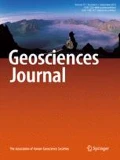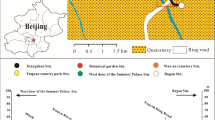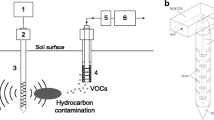Abstract
Plasma blasting by high-voltage arc discharge was performed in laboratory-scale soil samples to investigate fluid penetration. A plasma blasting device with a large-capacity capacitor and columnar soil samples with a diameter of 80 cm and a height of 60 cm were prepared. The columnar soil samples were made of sand and silt mixed in a 7:3 ratio (the A samples) or a 9:1 ratio (the B samples). When fluid was injected by pressure without plasma blasting, fluid penetrated into the soil only near the borehole, and the penetration area ratio was less than 10%. In further tests, fluid was injected by plasma blasting with different discharge energies of 1–27 kJ. When plasma blasting was performed once in the A samples, the penetration area ratios of the fluid were 16–25%; after five consecutive blasts, the penetration area ratios were 30–48%. When five consecutive plasma blasts were carried out on the B samples, the fluid penetration area ratios were 33–72%. This difference indicates that the fluid penetration area increases with higher discharge energy of plasma blasting and with a greater number of blasts. The fluid penetration radius was calculated to assess the fluid penetration volume. When the fluid was injected by hydraulic pressure only, the penetration radius was 9–12.4 cm, whereas the penetration radius was 27–33.2 cm when blasting was performed five times. The radius was increased by up to 200% by plasma blasting. In the field tests, the fluid injection in the test hole subjected to plasma blasting was greater by about 170% compared with the control test hole, in which the fluid was injected only by hydraulic pressure. In addition, the electrical resistivity around the test hole subjected to plasma blasting was markedly lower, and fluid diffused from this test hole to a minimum radius of 2 m. These results indicate that a cleaning agent will penetrate further and the remediation efficiency of contaminated soil will be improved if plasma blasting is applied for in situ cleaning of low-permeability contaminated soil.
Similar content being viewed by others
References
Aggelopoulos, C.A., Hatzisymeon, M., Tataraki, D., and Rassias, G., 2020, Remediation of ciprofloxacin-contaminated soil by nanosecond pulsed dielectrical barrier discharge plasma: influencing factors and degradation mechanisms. Chemical Engineering Journal, 393, 124768. https://doi.org/10.1016/j.cej.2020.124768
Baltazar-Lopez, M., Brandhorst, H., Burell, Z., and Heffernan, M., 2009, Analysis and simulations of low power plasma blasting for processing lunar materials. 7th International Energy Conversion Engineering Conference, Denver, Aug. 2–5, AIAA 2009-4550. https://doi.org/10.2514/6.2009-4550
Best, S., Baltazar-Lopez, M.E., Burell, Z.M., Brandhorst, H.W., Heffernan, M.E., and Rose, M.F., 2008, A low power approach for processing lunar materials. Proceedings of the 6th International Energy Conversion Engineering Conference (IECEC), Cleveland, Jul. 28–30, AIAA 2008-5710. https://doi.org/10.2514/6.2008-5710
Chen, W., Maurel, O., Reess, T., Ferron, A., La Borderie, C., Pijaudier-Cabot, G., and Rey-Bethbeder, F., 2012, Experimental study on an alternative oil stimulation technique for tight gas reservoirs based on dynamic shock waves generated by pulsed arc electrohydraulic discharges. Journal of Petroleum Science and Engineering, 88, 67–74.
Christiansen, C. and Wood, J.S.A., 2006, Environmental fracturing in clay till deposits. Master Thesis, Institute of Environment & Resources, Technical University of Denmark, Kongens Lyngby, 253 p.
Dahlin, T. and Zhou, B., 2004, A numerical comparison of 2D resistivity imaging with 10 electrode arrays. Geophysical Prospecting, 52, 379–398.
EPA, 1995, In situ remediation technology status report: hydraulic and pneumatic fracturing. EPA Report, EPA542-K-94-005, United States Environmental Protection Agency, Washington DC, 16 p.
EPA, 2004, Cleaning up the nation’s waste sites: markets and technology trends (2004 edition). EPA Report, EPA-542-R-04-015, United States Environmental Protection Agency, Washington DC, 338 p.
EPA, 2007, Treatment technologies for site cleanup: annual status report (12th edition). EPA Report, EPA-542-R-07-012, United States Environmental Protection Agency, Washington DC, 290 p.
Fawzy, E.M., 2008, Soil remediation using in situ immobilisation techniques. Chemistry and Ecology, 24, 147–156.
Ferrucci, A., Vocciante, M., Bagatin, R., and Ferro, S., 2017, Electrokinetic remediation of soils contaminated by potentially toxic metals: dedicated analytical tools for assessing the contamination baseline in a complex scenario. Journal of Environmental Management, 203, 1163–1168.
Frank, U. and Barkley, N., 1995, Remediation of low permeability subsurface formations by fracturing enhancement of soil vapor extraction. Journal of Hazardous Materials, 40, 191–201.
Hammon, J., Hopwood, D., Klatt, M., and Tatman, T., 2001, Electrical pulse rock sample disaggregator. 28th IEEE International Conference on Plasma Science and 13th IEEE International Pulsed Power Plasma Science, Las Vegas, Jun. 17–22, p. 1142–1145. https://doi.org/10.1109/PPPS.2001.1001747
Huguenot, D., Moisset, E., van Hullebusch, E.D., and Oturan, M.A., 2015, Combination of surfactant enhanced soil washing and electro-Fenton process for the treatment of soils contaminated by petroleum hydrocarbons. Journal of Environmental Management, 153, 40–47.
Ikkurthi, V.R., Tahiliani, K., and Chaturvedi, S., 2002, Simulation of crack propagation in rock in plasma blasting technology. Shock Waves, 12, 145–152.
Jang, H.S., Kim, K.J., Song, J.Y., An, S.G., and Jang, B.A., 2020, An experimental study to improve permeability and cleaning efficiency of oil contaminated soil by plasma blasting. The Journal of Engineering Geology, 30, 557–575. (in Korean with English abstract)
Kang, H.C., Han, B.G., Kim, J.D., Seo, S.W., Shin, C.H., and Park, J.S., 2017, Evaluation of soil flushing column test for oil-contaminated soil treatment. Clean Technology, 23, 302–307. (in Korean with English abstract)
Langefors, U. and Kihlström, B., 1978, The Modern Technique of Rock Blasting (3rd edition). Wiley, New York, 438 p.
Lee, K.H., Seo, H.J., Park, J.H., Ahn, H.Y., Kim, K.S., and Lee, I.M., 2012, A study on correlation between electrical resistivity obtained from electrical resistivity logging and rock mass rating in-situ tunnelling site. Journal of Korean Tunnelling and Underground Space Association, 14, 503–516. (in Korean with English abstract)
Lhotský, O., Kukačka, J., Slunský, J., Marková, K., Nemecek, J., Knytl, V., and Cajthaml, T., 2021, The effects of hydraulic/pneumatic fracturing-enhanced remediation (FRAC-IN) at a site contaminated by chlorinated ethenes: a case study. Journal of Hazardous Materials, 417, 125883. https://doi.org/10.1016/j.jhazmat.2021.125883
Li, O.L.H., Chang, J.S., and Guo, Y., 2011, Pulsed arc electrohydraulic discharge characteristics, plasma parameters, and optical emission during contaminated pond water treatments. IEEE Electrical Insulation Magazine, 27, 8–17.
Li, Z., Yu, J.W., and Nerentnieks, I., 1996, A new approach to electrokinetic remediation of soils polluted by heavy metals. Journal of Contaminant Hydrology, 22, 241–253.
Liu, J.W., Wei, K.H., Xu, S.W., Cui, J., Ma, J., Xiao, X.L., Xi, B.D., and He, X.S., 2021, Surfactant-enhanced remediation of oil-contaminated soil and groundwater: a review. Science of the Total Environment, 756, 144142.
Loke, M.H., 1999, Electrical Imaging Surveys for Environmental and Engineering Studies: A Practical Guide to 2D and 3D Surveys. Geotomo Software, Gelugor, Malaysia, 70 p.
Maurel, O., Reess, T., Matallah, M., Ferron, A.D., Chen, W., Borderie, C.L., Pijaudier-Cabot, G., Jacques, A., and Rey-Bethbeder, F., 2010, Electrohydraulic shock wave generation as a means to increase intrinsic permeability of mortar. Cement and Concrete Research, 40, 1631–1638.
Milsom, J., 2003, Field Geophysics (3rd edition). Wiley, New York, 244 p.
Park, B.S. and Yeo, S.C., 1971, Explanatory text of the geological map of Moggye sheet (scale 1: 50,000). Korea Institute of Geoscience and Mineral Resources, Daejeon, Republic of Korea, 24 p. (in Korean with English abstract)
Riu, H., Jang, H.S., Lee, B., Wu, C., and Jang, B.A., 2019, Laboratory-scale fracturing of cement and rock specimen by plasma blasting. Episodes, 42, 213–223.
Rosestolato, D., Bagatin, R., and Ferro, S., 2015, Electrokinetic remediation of soils polluted by heavy metals (mercury in particular). Chemical Engineering Journal, 264, 16–23.
Santos, E.V., Souza, F., Saez, C., Cañizares, P., Lanze, M.R.V., Martinez-Huitle, C.A., and Rodrigo, M.A., 2016, Application of electrokinetic soil flushing to four herbicides: a comparison. Chemosphere, 153, 205–211.
Schuring, J.R., Kosson, D.S., Fitzgerald, C.D., and Venkatraman, S., 1996, Pneumatic fracturing and multicomponent injection enhancement of in situ bioremediation. United States Patent, Patent No 5,560,737, Washington DC, 23 p.
Suthersan, S., 1999, Remediation Engineering: Design Concepts. CRC Press, Boca Raton, 237 p.
Touya, G., Reess, T., Pecastaing, L., Gibert, A., and Demens, P., 2006, Development of subsonic electrical discharges in water and measurements of the associated pressure waves. Journal of Physics D: Applied Physics, 39, 5236–5244.
Venkatraman, S.N., Schuring, J.R., Boland, T.M., Bossert, I.D., and Kosson, D.S., 1998, Application of pneumatic fracturing to enhance in-situ bioremediation. Journal of Soil Contamination, 7, 143–162.
Yan, F., Lin, B., Zhu, C., Guo, C., Zhou, Y., Zou, Q., and Liu, T., 2016, Using high-voltage electrical pulses to crush coal in an air environment: an experimental study. Powder Technology, 298, 50–56.
Yang, J.W. and Lee, Y.J., 2007, Status of soil remediation and technology development in Korea. Korean Chemical Engineering Research, 45, 311–318. (in Korean with English abstract)
Zhan, J., Liu, Y., Cheng, W., Zhang A., Li, R., Li, X., Ognier, S., Cai, S., Yang, C., and Liu, J., 2018, Remediation of soil contaminated by fluorene using needle-plate pulsed corona discharge plasma. Chemical Engineering Journal, 334, 2124–2133.
Zhu, L., He, Z.H., Li, P., Xu, T.S., Zhao, H., Zhao, X.F., and Gao, Z.W., 2013, The research on the pulsed arc electrohydraulic discharge and its application in treatment of the ballast water. Journal of Electrostatics, 71, 728–733.
Acknowledgments
This study was supported by Korea Environment Industry & Technology Institute (KEITI) through the Sub-Surface Environmental Management (SEM) Project, funded by the Korea Ministry of Environment (MOE) (Grant 2020002480010).
Author information
Authors and Affiliations
Corresponding author
Additional information
Publisher’s Note
Springer Nature remains neutral with regard to jurisdictional claims in published maps and institutional affiliations.
Rights and permissions
About this article
Cite this article
Jang, HS., Baek, IJ., Song, JY. et al. Improvement of fluid penetration in soil by plasma blasting. Geosci J 26, 731–747 (2022). https://doi.org/10.1007/s12303-022-0020-3
Received:
Accepted:
Published:
Issue Date:
DOI: https://doi.org/10.1007/s12303-022-0020-3




